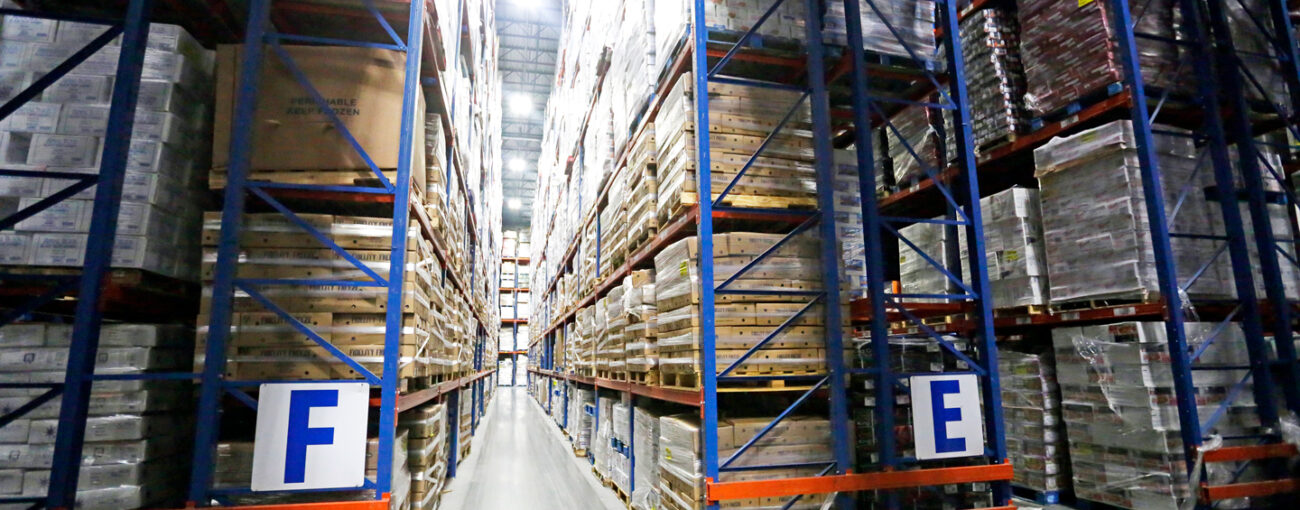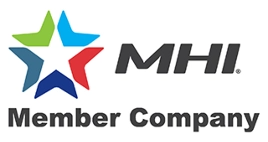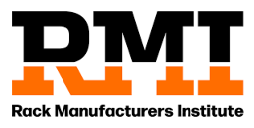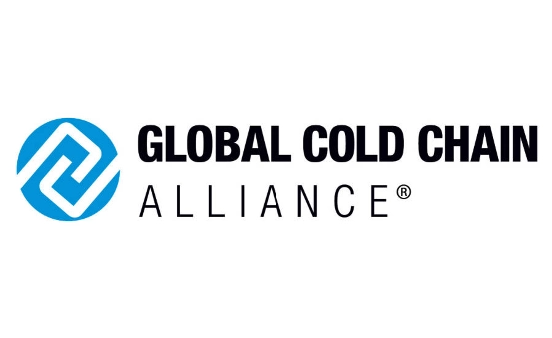The modern economy regularly witnesses increases in consumer demand for new and additional product lines. As a result, companies in markets such as Retail, E-Commerce and 3PL Warehousing can face the challenge of needing to store hundreds, if not thousands, of different SKUs in a single warehouse at any given time. Each SKU requires a pick face for selection, resulting in the need for a sizeable racking system. In a Real Estate Market Where Land Availability is Limited and Costs are at a Premium, designing a racking solution for a high SKU application to include thousands of pick faces while maximizing cubic footprint is critical. Very Narrow Aisle (known as VNA) racking systems presents themselves as a leading option for this because of their ability to accommodate selectivity while maximizing density.
VNA Racking Advantages
VNA racking uses a turret style fork truck that is maneuvered up and down the aisle by direction of a wire guide in the floor. Turret trucks have different capabilities than other types of fork trucks; as a result, the rack systems they work with are designed differently:
Turret trucks use swinging forks and do not need extra aisle space to turn into pick locations to access pallets. Thus, VNA aisles can be as narrow as under 6ft wide as opposed to 10ft wide in reach truck applications where trucks need the extra room to turn into pick faces. Consequently, VNA systems use more space for storage and less for aisles.
Turret trucks also have stronger masts that can lift products higher and more quickly. This allows for the racking system to be designed higher vertically instead of wider horizontally. Less footprint is needed when purchasing limited or expensive real estate. Also, higher systems create additional levels of shelving. This leads to more pick faces to accommodate higher SKU selectivity.
VNA racking systems’ reduced aisle space and greater heights equal selectivity with density. Altogether, its returns are measurable:
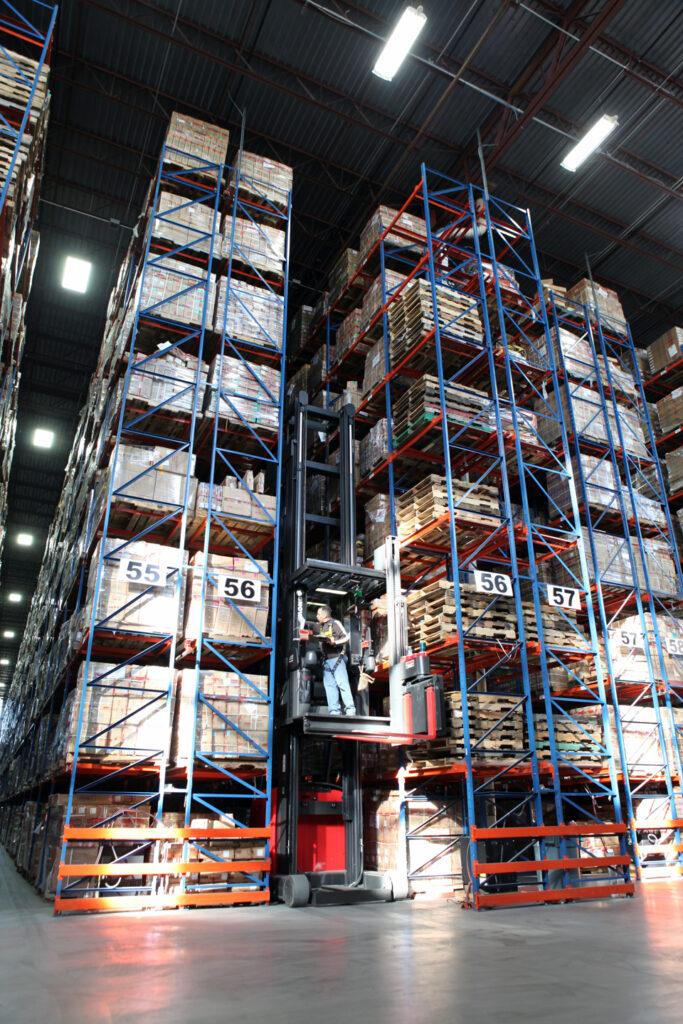
A worker picks cases from a turret truck in a Selective VNA Racking System.
- Increased Pick Faces
- increased Pallet Positions
- Greater Space Utilization
- Increased Productivity
- Real Estate Savings
Selective VNA Racking
Single Deep Selective Rack is commonly used in VNA system design for storing slow moving SKUs or where a lot of case picking occurs. In these scenarios, selective racking’s versatility is unmatched; with shelf levels adjustable at 1” centers, it offers the flexibility to meet changing product mix needs often associated with slow moving or case-picked SKUs.
While single deep selective racking can be used in VNA systems, double deep cannot be used. Turret trucks do not have the ability to reach and therefore cannot access the second pallet position. All picking with turret trucks, must occur from the face position. For SKUs that require storage of reserve pallets to keep up with higher throughput, Push Back Racking can be the ideal racking solution in a VNA system.
Push Back VNA Racking
Push back racking allows for pallets to be stored two to five positions deep in a VNA system. (Note in 5 deep systems, forces for loading must be checked and approved by the fork truck manufacturer to ensure the trucks are able to push 4 pallets back). This is because push back rack enables all product access to occur at the face position. Rear pallets, in the second position and back, rest on carts along a pitched track. Pallets are pushed back from the face position during loading and roll forward thanks to gravity during unloading. As a result, in VNA applications where throughput is high and little or no case picking is needed, maximum density can be attained through the use of push back racking.
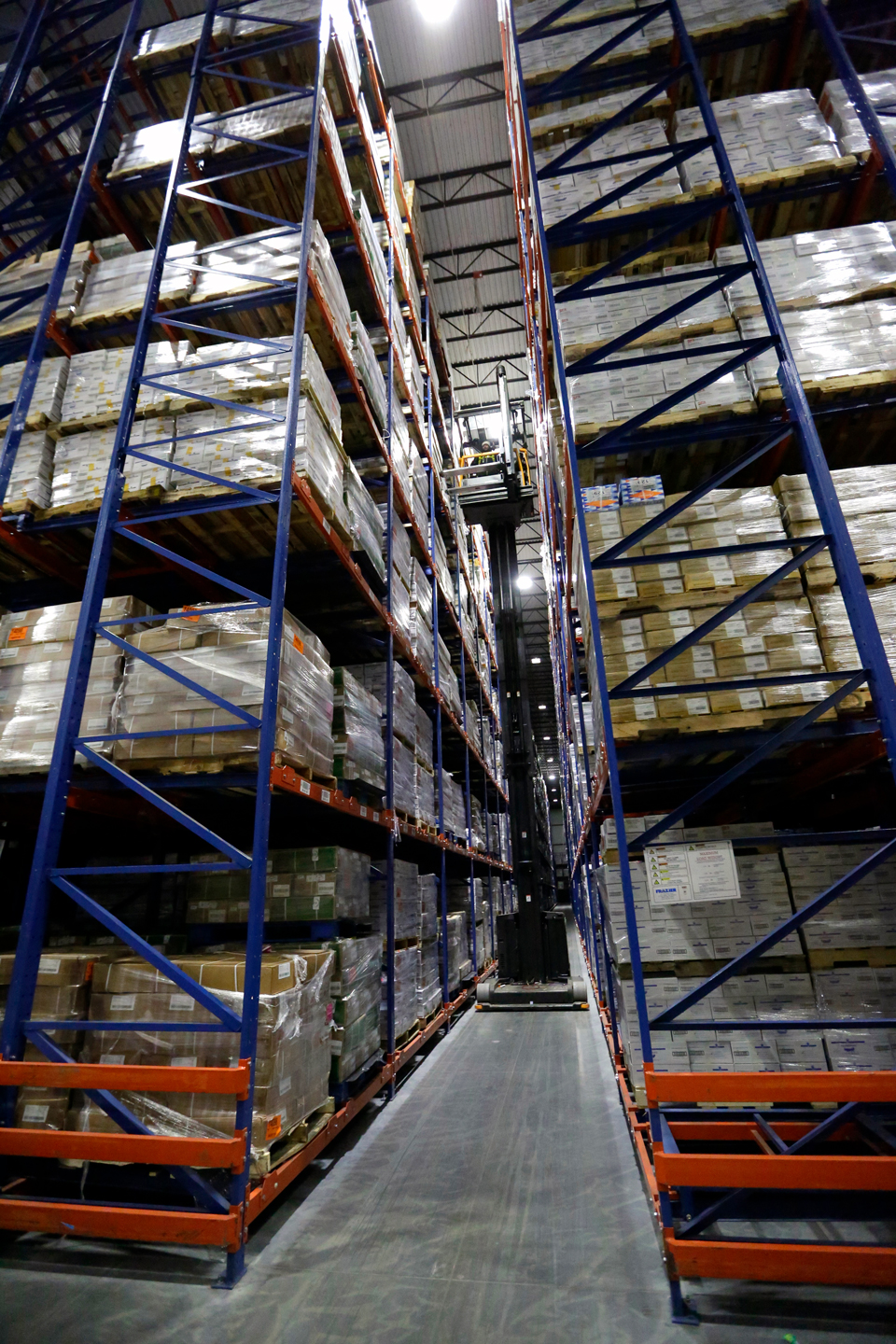
A fork truck travels down aisle in a Push Back VNA Racking System.
When using push back in VNA applications, high volume SKUs only require a single pick face. This is because push back allows for two to three times as much storage capacity right on the pick lanes. Inversely, single deep selective rack would require multiple pick faces to accommodate enough pallets for high volume SKUs. The added benefit of push back’s density here is further reduction in the number of aisles needed. In special VNA scenarios where higher volumes are present that exceed even push back’s maximum depth, other deep lane solutions, like the Mole IQ, can be used too!
Multi-Rack Type VNA Systems
The average warehouse has both faster and slower moving SKUs. Thus, sometimes a single rack type is not the solution. It is important to understand your product mix; storing different SKUs in multiple types of racking can optimize space and productivity.
Single deep selective and push back racks can work harmoniously in an individual VNA system. This could mean selective racking on one side of the aisle and push back on the other side. The selective racking can store slow moving SKU’s either where reserve is not needed or case picking occurs. Across the aisle, push back allows for greater density with enough reserve to maximize throughput for faster moving SKUs.
Go Structural
Structural Racking offers many advantages over roll-formed racking. Hot-rolled structural steel uses thicker materials and reinforced corners. Cold-rolled roll-formed rack is reliant upon its shape to function. The construction of structural lends itself to both greater capacity and durability in VNA racking design:
Capacity – VNA racking goes particularly high. Taller racking means more pallets stored vertically, which in turn means more stress on the racking frames. Roll-formed’s flimsy construction does not allow it to support heavier capacities at the increased heights that VNA systems achieve. Structural, however, has the ability to handle heavier loads with ease, even in a VNA system. The ability to Box Uprights on structural racking can allow for even more substantially increased carrying capacity.
Durability – It’s true, VNA systems generally take less product damage from fork trucks, because the truck does not turn into the pick face of the racking. There is risk, however, of the truck not being lined up with its wire guide and consequentially colliding with the rack. Because of the weight of the trucks, if they collide with the rack, damage can be violent. Structural racking will be better able to with such collision. Shape reliant roll-formed racking, however, will completely buckle from the weight of the trucks and may result in a catastrophic total rack collapse.
As a note of caution, once you lock into a VNA system, you cannot do any ground level picking with single or double pallet jacks. The aisle is too tight to maneuver in; collision to the first 24” of the frame can and will occur. This does not always stop fork truck operators from foolishly attempting to run pallet jacks, or even reach trucks, down a VNA aisle. Structural racking protects better against damage caused by this.
Choose Frazier
Frazier Industrial has a plethora of experience designing VNA racking systems that make the best use of our customers’ cubic footprints. In fact, Frazier was a pioneer in working with fork truck manufacturers to provide racking that worked alongside their VNA wire guided vehicles.
Frazier can help you with VNA racking that vastly increases pick faces and pallet positions in your existing space or limits the real estate you need when planning a new building. Designing to each customer’s storage and retrieval requirements is our priority. Contact Us today to maximize your space and make a difference in your SKU capacity.

